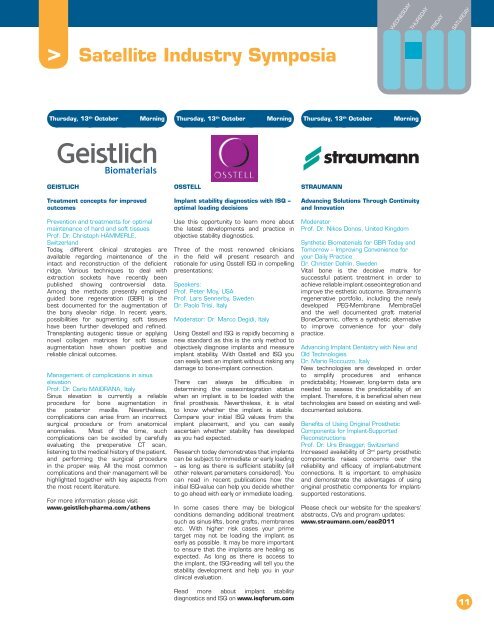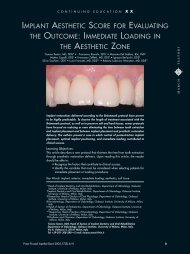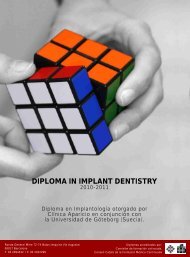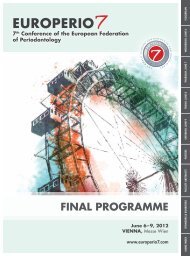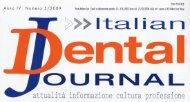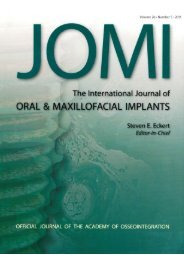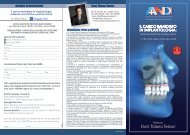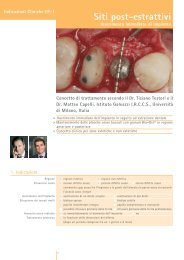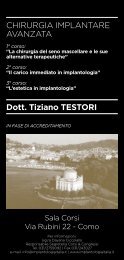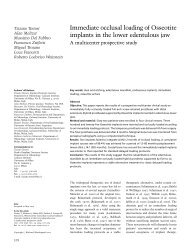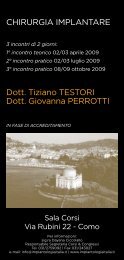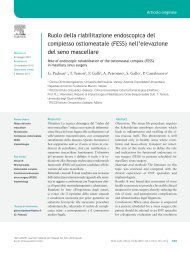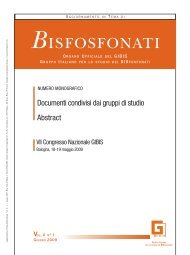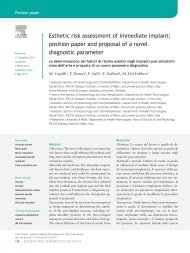Treatment planning in implant dentistry - Colloquium
Treatment planning in implant dentistry - Colloquium
Treatment planning in implant dentistry - Colloquium
You also want an ePaper? Increase the reach of your titles
YUMPU automatically turns print PDFs into web optimized ePapers that Google loves.
WEDNESDAY<br />
THURSDAY<br />
FRIDAY<br />
SATURDAY<br />
> Satellite Industry Symposia<br />
Thursday, 13 th October<br />
Morn<strong>in</strong>g<br />
Thursday, 13 th October<br />
Morn<strong>in</strong>g<br />
Thursday, 13 th October<br />
Morn<strong>in</strong>g<br />
GEISTLICH<br />
OSSTELL<br />
STRAUMANN<br />
<strong>Treatment</strong> concepts for improved<br />
outcomes<br />
Prevention and treatments for optimal<br />
ma<strong>in</strong>tenance of hard and soft tissues<br />
Prof. Dr. Christoph HÄMMERLE,<br />
Switzerland<br />
Today, different cl<strong>in</strong>ical strategies are<br />
available regard<strong>in</strong>g ma<strong>in</strong>tenance of the<br />
<strong>in</strong>tact and reconstruction of the deficient<br />
ridge. Various techniques to deal with<br />
extraction sockets have recently been<br />
published show<strong>in</strong>g controversial data.<br />
Among the methods presently employed<br />
guided bone regeneration (GBR) is the<br />
best documented for the augmentation of<br />
the bony alveolar ridge. In recent years,<br />
possibilities for augment<strong>in</strong>g soft tissues<br />
have been further developed and ref<strong>in</strong>ed.<br />
Transplant<strong>in</strong>g autogenic tissue or apply<strong>in</strong>g<br />
novel collagen matrices for soft tissue<br />
augmentation have shown positive and<br />
reliable cl<strong>in</strong>ical outcomes.<br />
Management of complications <strong>in</strong> s<strong>in</strong>us<br />
elevation<br />
Prof. Dr. Carlo MAIORANA, Italy<br />
S<strong>in</strong>us elevation is currently a reliable<br />
procedure for bone augmentation <strong>in</strong><br />
the posterior maxilla. Nevertheless,<br />
complications can arise from an <strong>in</strong>correct<br />
surgical procedure or from anatomical<br />
anomalies. Most of the time, such<br />
complications can be avoided by carefully<br />
evaluat<strong>in</strong>g the preoperative CT scan,<br />
listen<strong>in</strong>g to the medical history of the patient,<br />
and perform<strong>in</strong>g the surgical procedure<br />
<strong>in</strong> the proper way. All the most common<br />
complications and their management will be<br />
highlighted together with key aspects from<br />
the most recent literature.<br />
For more <strong>in</strong>formation please visit<br />
www.geistlich-pharma.com/athens<br />
Implant stability diagnostics with ISQ –<br />
optimal load<strong>in</strong>g decisions<br />
Use this opportunity to learn more about<br />
the latest developments and practice <strong>in</strong><br />
objective stability diagnostics.<br />
Three of the most renowned cl<strong>in</strong>icians<br />
<strong>in</strong> the field will present research and<br />
rationale for us<strong>in</strong>g Osstell ISQ <strong>in</strong> compell<strong>in</strong>g<br />
presentations:<br />
Speakers:<br />
Prof. Peter Moy, USA<br />
Prof. Lars Sennerby, Sweden<br />
Dr. Paolo Trisi, Italy<br />
Moderator: Dr. Marco Degidi, Italy<br />
Us<strong>in</strong>g Osstell and ISQ is rapidly becom<strong>in</strong>g a<br />
new standard as this is the only method to<br />
objectively diagnose <strong>implant</strong>s and measure<br />
<strong>implant</strong> stability. With Osstell and ISQ you<br />
can easily test an <strong>implant</strong> without risk<strong>in</strong>g any<br />
damage to bone-<strong>implant</strong> connection.<br />
There can always be difficulties <strong>in</strong><br />
determ<strong>in</strong><strong>in</strong>g the osseo<strong>in</strong>tegration status<br />
when an <strong>implant</strong> is to be loaded with the<br />
f<strong>in</strong>al prosthesis. Nevertheless, it is vital<br />
to know whether the <strong>implant</strong> is stable.<br />
Compare your <strong>in</strong>itial ISQ values from the<br />
<strong>implant</strong> placement, and you can easily<br />
ascerta<strong>in</strong> whether stability has developed<br />
as you had expected.<br />
Research today demonstrates that <strong>implant</strong>s<br />
can be subject to immediate or early load<strong>in</strong>g<br />
– as long as there is sufficient stability (all<br />
other relevant parameters considered). You<br />
can read <strong>in</strong> recent publications how the<br />
<strong>in</strong>itial ISQ-value can help you decide whether<br />
to go ahead with early or immediate load<strong>in</strong>g.<br />
In some cases there may be biological<br />
conditions demand<strong>in</strong>g additional treatment<br />
such as s<strong>in</strong>us-lifts, bone grafts, membranes<br />
etc. With higher risk cases your prime<br />
target may not be load<strong>in</strong>g the <strong>implant</strong> as<br />
early as possible. It may be more important<br />
to ensure that the <strong>implant</strong>s are heal<strong>in</strong>g as<br />
expected. As long as there is access to<br />
the <strong>implant</strong>, the ISQ-read<strong>in</strong>g will tell you the<br />
stability development and help you <strong>in</strong> your<br />
cl<strong>in</strong>ical evaluation.<br />
Advanc<strong>in</strong>g Solutions Through Cont<strong>in</strong>uity<br />
and Innovation<br />
Moderator<br />
Prof. Dr. Nikos Donos, United K<strong>in</strong>gdom<br />
Synthetic Biomaterials for GBR Today and<br />
Tomorrow – Improv<strong>in</strong>g Convenience for<br />
your Daily Practice<br />
Dr. Christer Dahl<strong>in</strong>, Sweden<br />
Vital bone is the decisive matrix for<br />
successful patient treatment <strong>in</strong> order to<br />
achieve reliable <strong>implant</strong> osseo<strong>in</strong>tegration and<br />
improve the esthetic outcome. Straumann’s<br />
regenerative portfolio, <strong>in</strong>clud<strong>in</strong>g the newly<br />
developed PEG-Membrane MembraGel<br />
and the well documented graft material<br />
BoneCeramic, offers a synthetic alternative<br />
to improve convenience for your daily<br />
practice.<br />
Advanc<strong>in</strong>g Implant Dentistry with New and<br />
Old Technologies<br />
Dr. Mario Roccuzzo, Italy<br />
New technologies are developed <strong>in</strong> order<br />
to simplify procedures and enhance<br />
predictability; However, long-term data are<br />
needed to assess the predictability of an<br />
<strong>implant</strong>. Therefore, it is beneficial when new<br />
technologies are based on exist<strong>in</strong>g and welldocumented<br />
solutions.<br />
Benefits of Us<strong>in</strong>g Orig<strong>in</strong>al Prosthetic<br />
Components for Implant-Supported<br />
Reconstructions<br />
Prof. Dr. Urs Braegger, Switzerland<br />
Increased availability of 3 rd party prosthetic<br />
components raises concerns over the<br />
reliability and efficacy of <strong>implant</strong>-abutment<br />
connections. It is important to emphasize<br />
and demonstrate the advantages of us<strong>in</strong>g<br />
orig<strong>in</strong>al prosthetic components for <strong>implant</strong>supported<br />
restorations.<br />
Please check our website for the speakers’<br />
abstracts, CVs and program updates:<br />
www.straumann.com/eao2011<br />
Read more about <strong>implant</strong> stability<br />
diagnostics and ISQ on www.isqforum.com<br />
11


